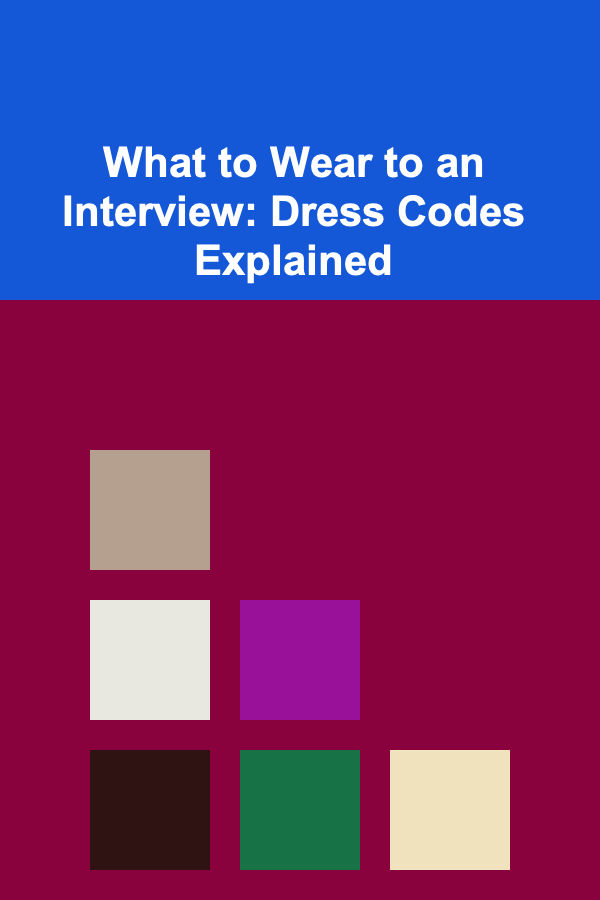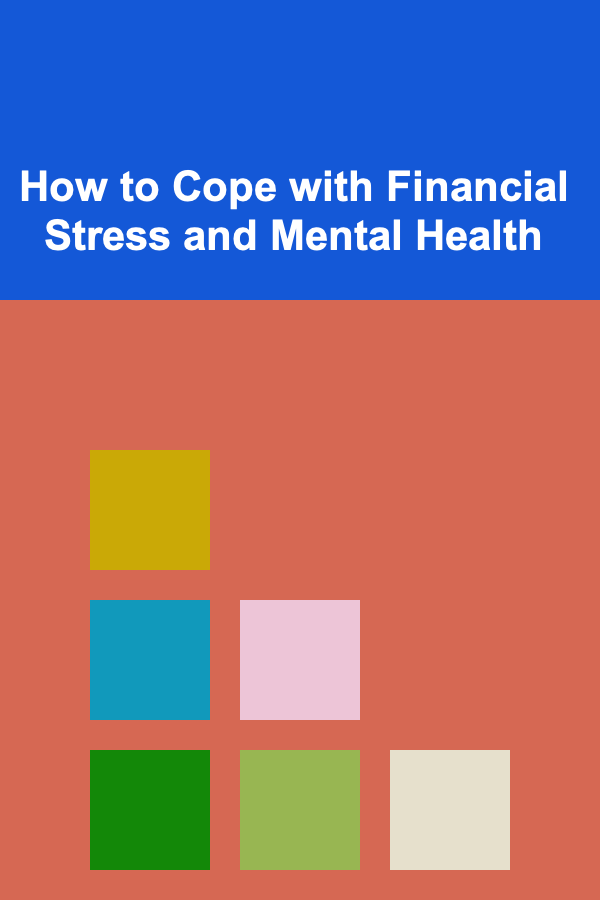
What to Wear to an Interview: Dress Codes Explained
ebook include PDF & Audio bundle (Micro Guide)
$12.99$11.99
Limited Time Offer! Order within the next:

The way you present yourself during a job interview plays a crucial role in making a positive first impression. Your outfit, which includes clothing, accessories, and overall grooming, communicates more than just your personal style---it reflects your professionalism, understanding of the company culture, and respect for the interview process. While choosing the right outfit can seem like a daunting task, especially with different industries and companies having varying dress codes, understanding the nuances of professional attire can help you confidently navigate the process.
In this actionable guide, we will break down the essentials of what to wear to an interview, discuss the various dress codes you may encounter, and offer tips to ensure your attire aligns with the job you're applying for.
Understanding Dress Codes
Before selecting your outfit, it's important to understand the company's dress code. Dress codes in the workplace can vary significantly based on industry, company culture, and even location. Broadly speaking, these dress codes can be categorized into four major types: business formal , business casual , casual , and creative/casual. Each has its own expectations and standards. Let's explore each of these in detail.
1. Business Formal
Business formal is the most traditional and conservative dress code, typically seen in corporate sectors such as finance, law, banking, and government. Interviews in these fields expect candidates to demonstrate a high level of professionalism, and your attire should reflect this expectation.
For Men:
- Suit: A dark, tailored suit (navy, black, or charcoal gray) is the go-to choice. Ensure that your suit fits well---neither too tight nor too loose.
- Shirt: A long-sleeve, button-down shirt in a solid color like white or light blue works best.
- Tie: A silk tie in a conservative pattern (e.g., stripes or solid colors) is essential.
- Shoes: Black or dark brown leather shoes, such as Oxfords or brogues, should be polished and in good condition.
- Accessories: Keep accessories minimal. A wristwatch and a belt that matches your shoes are usually sufficient.
For Women:
- Suit: A tailored suit, either pantsuit or skirt suit, in a dark color is ideal. Opt for a knee-length skirt or professional trousers.
- Blouse: A simple, well-fitted blouse in neutral tones like white, cream, or light blue.
- Shoes: Closed-toe heels or flats in a neutral color. The heel should be modest---nothing too high or flashy.
- Accessories: Choose understated jewelry, such as stud earrings and a simple necklace. Keep makeup and hair professional and neat.
Key Points:
- Stick to neutral or dark colors for suits and shirts.
- Avoid excessive jewelry, perfumes, or accessories.
- Ensure that your clothing is well-fitted and free of wrinkles.
2. Business Casual
Business casual is a more relaxed dress code compared to business formal but still maintains a professional appearance. This dress code is common in industries like technology, education, and marketing. While it's more lenient, it's important to look polished and well put-together.
For Men:
- Blazer or Sport Coat: While a full suit may not be necessary, a blazer or sport coat paired with dress slacks is a good choice.
- Shirt: A button-down shirt is still expected, but you can opt for a patterned shirt or even a polo in place of a formal dress shirt.
- Trousers: Chinos or dress pants in neutral colors like beige, navy, or gray work well.
- Shoes: Leather loafers or dress shoes are appropriate. Avoid sneakers.
- Accessories: A belt that matches your shoes and a simple watch. Ties are optional.
For Women:
- Blouse or Button-Down Shirt: You can wear a blouse, a knit top, or a button-down shirt. Patterns like stripes or florals are acceptable, but make sure they're not too bold.
- Skirt or Slacks: A knee-length skirt or dress pants are suitable. Ensure that the fit is professional and the hemline is modest.
- Shoes: Closed-toe flats or low heels. Avoid overly casual footwear like sandals or sneakers.
- Accessories: Keep accessories minimal---small earrings and simple jewelry are ideal.
Key Points:
- Stick to classic styles, but don't be afraid to add a touch of personality.
- Dress in a way that shows you understand the professional nature of the environment.
- Clothes should still fit well and look neat.
3. Casual
A casual dress code is becoming more common, especially in creative industries, start-ups, and tech companies. However, "casual" doesn't mean "sloppy." Even in casual environments, you should still strive to look put-together and professional.
For Men:
- Shirt: A well-fitted T-shirt, polo, or casual button-down shirt is acceptable. If you choose a T-shirt, opt for a plain or subtly patterned one (avoid graphics or logos).
- Pants: Jeans or chinos in a dark color are best. Avoid overly distressed or torn denim.
- Shoes: Casual loafers, desert boots, or clean, minimal sneakers can work.
- Accessories: You can add a watch or minimal accessories, but nothing too flashy.
For Women:
- Top: A casual blouse, knit top, or T-shirt can be worn, but ensure it's clean and free of any visible wrinkles. A nice sweater or cardigan can also work well.
- Pants: Jeans or casual trousers in a clean, neat style. Avoid anything too tight or worn out.
- Shoes: Flats, loafers, or minimal sneakers are suitable. Avoid sandals or flip-flops unless specifically acceptable in the company's culture.
- Accessories: Choose simple, understated accessories.
Key Points:
- Even though it's casual, your outfit should still look intentional and neat.
- Avoid overly casual items like ripped jeans, flip-flops, or graphic tees.
- Make sure your clothes are free from stains, wrinkles, or damage.
4. Creative/Casual
In highly creative fields such as fashion, advertising, or media, the dress code can vary widely, but there's usually more room for personal expression. While it's important to maintain a professional look, you can be more adventurous with your clothing choices.
For Men:
- Shirt: A button-down shirt, sweater, or even a high-quality T-shirt may be acceptable. Don't be afraid to incorporate colors or unique patterns that reflect your style.
- Trousers/Jeans: Slim-fit trousers, tailored chinos, or dark jeans are acceptable.
- Shoes: Trendy loafers, boots, or designer sneakers can work well, depending on the environment.
- Accessories: Don't shy away from stylish accessories like scarves, watches, or bracelets, but keep them balanced to avoid an overly busy look.
For Women:
- Top: You can express yourself through fashion-forward blouses, tops, or even dresses. Prints and bright colors are acceptable but should still maintain a professional appearance.
- Bottoms: Tailored trousers, skirts, or even smart, dark jeans may be appropriate.
- Shoes: Fashionable flats, ankle boots, or smart sneakers may work, depending on the specific company.
- Accessories: Creative accessories like a statement necklace, scarf, or unique earrings can add personality.
Key Points:
- Express individuality, but always keep professionalism in mind.
- Make sure your attire is appropriate for the company's specific creative culture.
- Avoid looking too casual or unpolished---your look should be intentional.
General Tips for All Interviews
Regardless of the dress code, there are a few essential points that apply to any interview outfit:
1. Research the Company Culture
Before selecting your outfit, take some time to research the company culture. Look at photos of employees on the company website or social media, or read company reviews to get a sense of the work environment. This will give you a better understanding of the expected dress code and help you avoid over- or under-dressing.
2. Prioritize Cleanliness and Grooming
Regardless of the dress code, cleanliness and grooming are non-negotiable. Ensure that your clothes are clean, pressed, and free of lint or pet hair. Your hair should be neatly styled, and makeup (if worn) should be subtle and professional. Pay attention to your hygiene, including fresh breath and trimmed nails.
3. Choose Comfort and Confidence
When selecting an outfit, prioritize comfort. You want to feel confident and at ease in what you're wearing, as this will translate into your body language during the interview. Avoid outfits that are too tight, too loose, or uncomfortable to move in.
4. Avoid Distractions
Your outfit should enhance your professionalism, not distract from your qualifications. Avoid overly flashy accessories, excessive perfume or cologne, or clothing that might draw too much attention. The focus should be on your skills, experience, and ability to contribute to the company, not on your wardrobe.
Conclusion
Choosing the right outfit for an interview is essential in making a lasting first impression. Understanding the different dress codes and tailoring your attire accordingly will help you present yourself as a professional who is serious about the opportunity. Whether you're applying for a formal corporate role or a creative position, dressing appropriately for the company culture shows respect for the interview process and helps you feel confident. Remember, the goal is to look polished, put-together, and comfortable---so that the interviewer can focus on your qualifications, not your wardrobe.

How to Create an Amazing Party Favors Station for Your Guests
Read More
How to Make a Checklist for Optimizing Website Images and Media
Read More
How to Organize Your Workspace for Enhanced Creativity
Read More
How to Use Credit Cards Responsibly to Build Credit
Read More
Securing Your Data: Best Practices for a DBA in Today's World
Read More
How to Cope with Financial Stress and Mental Health
Read MoreOther Products

How to Create an Amazing Party Favors Station for Your Guests
Read More
How to Make a Checklist for Optimizing Website Images and Media
Read More
How to Organize Your Workspace for Enhanced Creativity
Read More
How to Use Credit Cards Responsibly to Build Credit
Read More
Securing Your Data: Best Practices for a DBA in Today's World
Read More